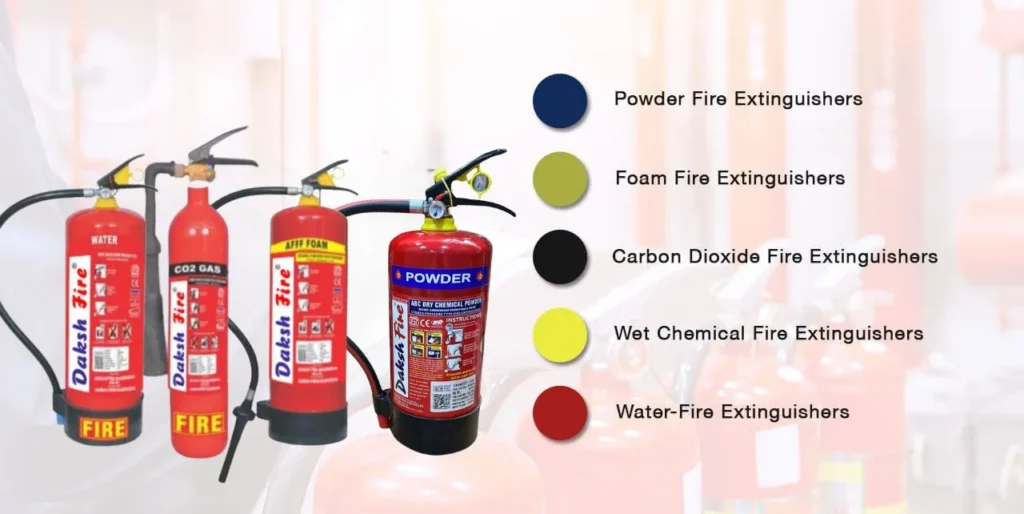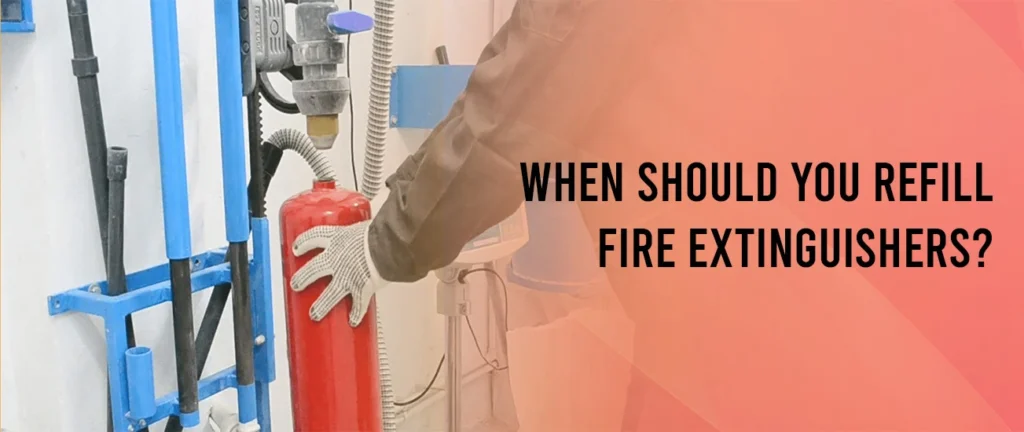There aren't any posts currently published in this category.
Fire Extinguishers play a vital role in protecting people and property in a fire emergency. One should have knowledge of the Types of Fire extinguishers so that one can respond quickly when it counts, so here we are, Read our blog to learn about the different Types of Fire extinguishers and their uses.
Everyone is aware that having a fire extinguisher at work is needed, and they should all be aware of its location.
You must make sure that the appropriate extinguisher is placed for the potential fire threats in your building if you want your workplace to be truly safe.
Various Types of Fire Extinguisher
When it comes to fire extinguishers, one gets to see various Types of Fire extinguishers, like CO2 Fire Extinguishers, Powder Fire Extinguishers, Wet Chemical Fire Extinguishers, and so on. Knowing which extinguisher to use is essential given the variety of extinguishers available. It could get worse if you use the incorrect one to put out the flames.

- Carbon Dioxide (Co2) Fire Extinguishers
The CO2 fire Extinguisher has a black label on it. Co2 is written in white on the black label which makes it easy to recognize it.
These Types of Fire Extinguisher are suitable for Class B and Class C Fires, but it is best for Class B Fires. It is safe to use on fires involving electricity. It is not to be used in confined areas because it can cause asphyxiation.
- Mechanical Foam Fire Extinguishers
Mechanical Foam Fire Extinguisher has a yellow label on it. One can recognize it with the word “FOAM” written in red on the yellow indicator panel.
It is suitable for Class A and Class B Fires. It is not suitable for use on fires involving electricity.
- Powder Fire Extinguishers
The Powder Fire Extinguisher has a blue label on it. The word “POWDER” is written in white color on the blue indicator panel. It is suitable for Class A, Class B, and Class C Fires, and is best for Class B Fires but has limited use on Class A Fires.
There are three types of Powder Fire extinguishers such as ABC Fire Extinguisher, DCP Fire Extinguisher, and D Class Fire Extinguisher, but the most popular among the three is ABC Fire Extinguisher. Powder Fire Extinguishers are not safe to use in confined areas due to inflation.
- Water Fire Extinguishers
Water-Fire Extinguishers have a red label, and the word “WATER” is written in white on the red indicator panel. It is suitable for use on only Class A Fires, paper, wood, textiles, and fabrics. It is not suitable for combustible liquids, cooking fats, etc.
There are two types of Water Fire Extinguisher – Water Spray and Water Mist. The Water Spray Fire Extinguishers are suitable for only Class A Fires. The Water Mist Fire Extinguishers are suitable for Class A, Class F, and Class E Fires.
- Wet Chemical Fire Extinguishers
Wet Chemical Fire Extinguisher has a yellow label on it. Wet Chemical is written in red on the yellow label, making it easy to recognize.
These Types of Fire extinguishers are suitable for Class A and Class F Fires. These Types of Fire extinguishers are also known as Kitchen Fire extinguishers (“K-TYPE”). This is the only fire extinguisher under SS Body (Stainless Steel) and MS Body (Mild Steel).
Wet Chemical Fire Extinguisher is specially designed for use on cooking oil/ fat fires, and is not suitable for use on electrical fires.

Extinguishers establish the first line of defense against fire. However, the Fire Extinguishers must be completely charged to put out the fire. However, most users of Fire Extinguishers are unsure as to how often to refill them. They should refer to the guide below. You can use it to gain all the information you require about how to Refill Fire Extinguishers. Continue reading the Blog to learn more.
Within a period of 2, 3, or 5 years
Each type of Fire Extinguisher has a different recharge condition. The fire waste extinguisher typically needs 5 years to recharge. Every two to three years, recharge the form-type Fire Extinguisher.
Used or partially Used Fire Extinguisher
Different factors, such as hot appliances, flawed electrical systems, irresponsible smoking, etc., might contribute to the fire. You can put out the fire with the use of Fire Extinguishers and other appropriate fire safety gear. Every time you use it, though, you must refill it in order for it to continue working. To keep the extinguisher ready for the next use, no matter how little you have dispensed, you must replenish it.
If the pressure gauge is displaying the red section
You must frequently inspect the Fire Extinguisher to ensure that it is functioning properly. Check the gauge’s pressure needle’s position when you are doing that. You do not need to use the fire extinguisher refilling service if the needle is in the green zone. To maintain the manufacturer-required pressure levels, you must refill it if it is in the red zone.
If the extinguisher is not cared for
The way a Fire Extinguisher is stored can dramatically lengthen its lifespan. To preserve the extinguishers’ qualities, you must keep them in a spotless interior space. If you do not do that, rain, sunlight, and UV radiation can cause significant rusting, degradation, and corrosion. To keep it operational in such circumstances, you must bring it to the Fire Extinguishers Refilling Service.
If the extinguisher is not inspected for a long time
Checking on the equipment regularly is one of the most important ways to maintain the Fire Extinguishers’ functionality. If you do not do that, you will fail to notice any warning signals that your extinguisher is not in good operating order. Therefore, it is always preferable for you to bring the extinguisher to the professionals for refilling rather than utilizing such an extinguisher. You can prevent instances where the extinguisher might explode by doing this.
In conclusion, if you bring the Fire Extinguishers to the center for Refilling Fire Extinguishers, the professionals there can determine if they just need to be filled or whether they are fully broken. They will be able to dispose of it correctly because of it.
How To Refill Your Fire Extinguisher Cylinder
Once you have determined when to refill your cylinder, it is crucial to learn how to do it when the time comes.
- Depressurize the extinguisher entirely first. From the cylinder, take out the agent.
- The discharge valve should then be taken out of the cylinder.
- From the valve, take out the siphon tube, valve stem, and sprig.
- While evaluating the valve internally and externally for potential defects, clean the valve and replace the valve neck.
- Repair the valve. To guarantee correct seating and prevent future pressure loss, make sure the new valve stem is included in the reassembling process.
- Add the extinguishing substance—dry powder, water, or carbon dioxide—to the empty cylinder to fill it up. Make sure that the refilled content is suitable for the size of the unit and complies with the recharging instructions in the cylinder specification handbook.
- Repressurize the device as directed in the cylinder specification manual’s recharge instructions, using the proper pressurizing gas to achieve the necessary pressure.
- To weed out any leakage indications, do a leak test (often performed by a skilled technician).
- The discharge hose or nozzle should be replaced.
- Reweigh the extinguisher to make sure the overall weight is within the manufacturer’s permitted limitations.
Conclusion
One should have a clear understanding of the different Types of Fire Extinguishers and should know how to use them so that in the case of an emergency one can respond quickly and choose the suitable fire extinguisher and save one’s life.
To prevent fire damage to your house or commercial property, you must know when and how to replenish your fire extinguisher. If you have any inquiries about safeguarding your fire safety, get in touch with our experts.
